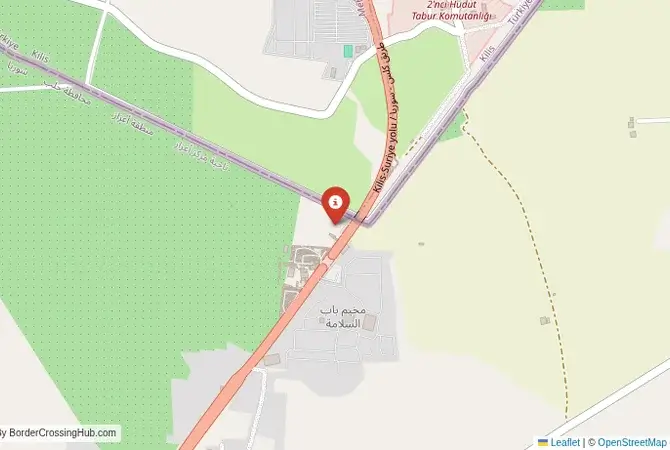
Approximate Border Location
Wait Times
30-120 min for pedestrians/vehicles
Operating Hours
Open 24 hours
Crossing Types
Pedestrians, vehicles, commercial
Border Type
Land crossing via road
Peak Times
Mornings (7-10 AM), weekends
Daily Crossings
~4000 travelers/vehicles
Currency Exchange
Available near Bab al-Salam (SYP, TRY)
Safety Information
Busy, security concerns
Languages Spoken
Arabic/Turkish
Accessibility Features
Ramps, elevators
About Bab al-Salam & Kilis
A Crossing in a Contested Land
Important Note for Travelers: This border crossing is located in an active and extremely dangerous conflict zone. It is controlled by various non-state actors and is not a normal international checkpoint. It has been closed to all but humanitarian aid and specific, authorized traffic for many years. Travel to this region is extremely dangerous and strictly forbidden. This guide is provided for historical and informational purposes only.
The border crossing at Bab al-Salam in Syria, connecting to the area near Öncüpınar (Kilis) in Turkey, is a journey into the heart of the northern Aleppo countryside, a region that has been a major frontline and a zone of foreign intervention in the Syrian Civil War. This is not a border for tourists; it is a highly strategic and heavily militarized checkpoint that serves as a vital link for the Turkish-controlled areas of northern Syria. To cross here is to enter a complex and volatile landscape of displaced persons camps, Turkish military bases, and the remnants of a decade of brutal conflict. It is a crossing defined by its immense strategic importance and its role in the ongoing geopolitical struggle for the future of Syria.
Operational Details
This checkpoint connects the Aleppo Governorate of Syria with the Kilis Province of Turkey. Its operational status is entirely dependent on the security situation and the policies of the Turkish government. For years, it has been closed to regular civilian traffic. It is a key entry point for Turkish military convoys, as well as for Turkish-backed Syrian opposition fighters. It is also a major conduit for Turkish-funded humanitarian and development aid into the “safe zone” that Turkey has established in northern Syria. The crossing is heavily fortified on both sides.
Before Crossing
Crossing borders gets messy sometimes, think political flare-ups or gates shutting fast. Good travel insurance is a must for handling doctor visits, trip disruptions, or security scares. Don’t get caught unprepared. To find a policy that’s got your back, check out reliable plans today for peace of mind.
A History of a Conflict Frontier
The history of this crossing is the history of the Syrian Civil War. The nearby Syrian city of Azaz has been a major prize, contested by a dizzying array of groups, including the Free Syrian Army, various Islamist factions, ISIS, and Kurdish forces. The Bab al-Salam crossing was captured by rebel forces early in the war. It became a vital supply line for the opposition in Aleppo. In recent years, the area has come under the direct control of Turkish-backed Syrian National Army factions, and Turkey has established a significant military and administrative presence in the region. The crossing is the main artery for this zone of Turkish influence.
The Border Crossing Procedure
There is no normal border crossing procedure for the public. The crossing is restricted to military personnel, authorized aid workers, and Syrians who have been granted special permission to cross for medical treatment or other specific reasons. The process is extremely rigorous and controlled by Turkish and Turkish-backed Syrian authorities. The area is frequently the target of attacks by various armed groups, making the crossing itself an extremely dangerous place to be. It is a logistical operation conducted in a complex and unpredictable security environment.
The Surrounding Region: Syria Side
On the Syrian side, the crossing is the gateway to the northern Aleppo countryside. The area is home to a huge population of internally displaced persons who live in sprawling camps. The historic city of Aleppo, a UNESCO World Heritage site that was once the largest city in Syria, has been devastated by the war. The region is a complex patchwork of territories controlled by different armed factions, and the security situation is extremely volatile.
The Surrounding Region: Turkey Side
On the Turkish side, the crossing is in the Kilis Province. The city of Kilis has been profoundly affected by the war. For years, it hosted a population of Syrian refugees that was larger than its native Turkish population, a situation that placed an immense strain on local services but was also handled with remarkable generosity by the local community. The city has been the target of cross-border rocket attacks. The nearby city of Gaziantep is a major economic hub and is famous for its magnificent Zeugma Mosaic Museum and its world-renowned cuisine.
Practical Travel Information
Travel on this route is impossible for independent travelers. The entire region is an active conflict zone. The official currencies are the Syrian Pound (SYP) in Syria (though the Turkish Lira is widely used in the Turkish-controlled areas) and the Turkish Lira (TRY) in Turkey. Any travel would have to be part of an accredited international aid organization or an official delegation and would involve extreme security precautions. The risks of kidnapping, shelling, and terrorist attacks are constant.
Final Considerations
The Bab al-Salam border crossing is a journey into the heart of a major geopolitical conflict. It is a place where the sovereignty of a nation has been fractured and where foreign powers exert direct control. It is a vital lifeline for a population dependent on outside aid, but it is also a military and strategic asset. It is a border that is not a gateway for tourists, but a key piece in the complex and tragic puzzle of the Syrian war. It is a powerful symbol of the new realities of a fragmented and broken state.
No reviews yet.
